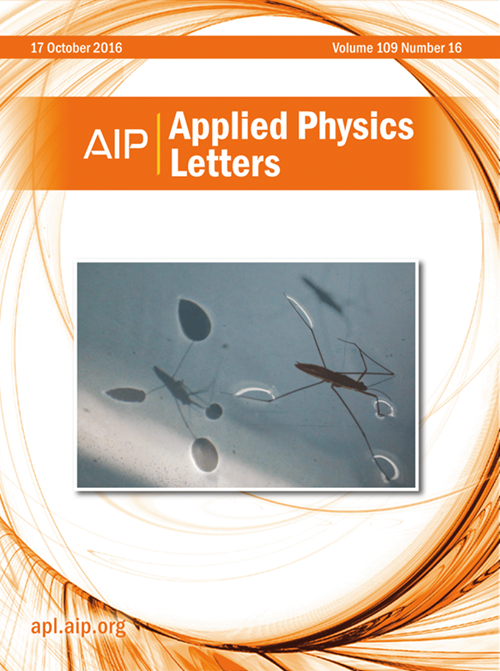Enhanced thermoelectric performance in organic thin films via MoO3-mediated contact resistance reduction and energy filtering
IF 3.5
2区 物理与天体物理
Q2 PHYSICS, APPLIED
引用次数: 0
Abstract
Organic thermoelectric (OTE) devices have garnered increasing attention as promising candidates for flexible and low-cost energy harvesting technologies. However, their performance has been largely constrained by high contact resistance, particularly when using cost-effective electrode materials such as aluminum, which exhibit poor energy level alignment with organic semiconductors. Herein, we demonstrate that the incorporation of a MoO3 interlayer between Al electrodes and ethylene glycol-doped poly(3,4-ethylenedioxythiophene):poly(styrene sulfonate) effectively reduces the contact resistance by alleviating the interfacial Schottky barrier. By systematically tuning the MoO3 thickness, we achieve a maximum output power of 56.1 pW at a temperature gradient of 3 K using a 4 nm MoO3 interlayer, which surpasses the performance of conventional OTE devices employing Au electrodes by 45%. Comprehensive electrical characterizations, including the transmission line method-based contact resistance analysis and temperature-dependent conductivity measurements, reveal that the optimized interfacial energy barrier of ∼0.10 eV facilitates efficient energy filtering, enhancing the Seebeck coefficient without degrading bulk transport properties. Our findings establish an effective interfacial engineering strategy for reducing contact resistance and optimizing energy filtering in OTE devices, offering a practical pathway toward scalable and low-cost thermoelectric module fabrication.通过moo3介导的接触电阻降低和能量滤波提高有机薄膜的热电性能
有机热电(OTE)器件作为一种灵活、低成本的能量收集技术,已经引起了越来越多的关注。然而,它们的性能在很大程度上受到高接触电阻的限制,特别是当使用具有成本效益的电极材料(如铝)时,这种材料与有机半导体表现出较差的能级对准。在此,我们证明了在Al电极和乙二醇掺杂的聚(3,4-乙烯二氧噻吩):聚(苯乙烯磺酸盐)之间掺入MoO3中间层通过减轻界面肖特基势垒有效地降低了接触电阻。通过系统地调整MoO3的厚度,我们使用4 nm的MoO3中间层在3 K的温度梯度下实现了56.1 pW的最大输出功率,这比使用Au电极的传统OTE器件的性能高出45%。综合电气特性,包括基于传输线方法的接触电阻分析和温度相关电导率测量,表明优化的界面能势垒为~ 0.10 eV有助于有效的能量滤波,提高塞贝克系数,而不会降低体输运性能。我们的研究结果为降低OTE器件的接触电阻和优化能量滤波建立了有效的界面工程策略,为可扩展和低成本的热电模块制造提供了一条实用的途径。
本文章由计算机程序翻译,如有差异,请以英文原文为准。
求助全文
约1分钟内获得全文
求助全文
来源期刊

Applied Physics Letters
物理-物理:应用
CiteScore
6.40
自引率
10.00%
发文量
1821
审稿时长
1.6 months
期刊介绍:
Applied Physics Letters (APL) features concise, up-to-date reports on significant new findings in applied physics. Emphasizing rapid dissemination of key data and new physical insights, APL offers prompt publication of new experimental and theoretical papers reporting applications of physics phenomena to all branches of science, engineering, and modern technology.
In addition to regular articles, the journal also publishes invited Fast Track, Perspectives, and in-depth Editorials which report on cutting-edge areas in applied physics.
APL Perspectives are forward-looking invited letters which highlight recent developments or discoveries. Emphasis is placed on very recent developments, potentially disruptive technologies, open questions and possible solutions. They also include a mini-roadmap detailing where the community should direct efforts in order for the phenomena to be viable for application and the challenges associated with meeting that performance threshold. Perspectives are characterized by personal viewpoints and opinions of recognized experts in the field.
Fast Track articles are invited original research articles that report results that are particularly novel and important or provide a significant advancement in an emerging field. Because of the urgency and scientific importance of the work, the peer review process is accelerated. If, during the review process, it becomes apparent that the paper does not meet the Fast Track criterion, it is returned to a normal track.
 求助内容:
求助内容: 应助结果提醒方式:
应助结果提醒方式:


